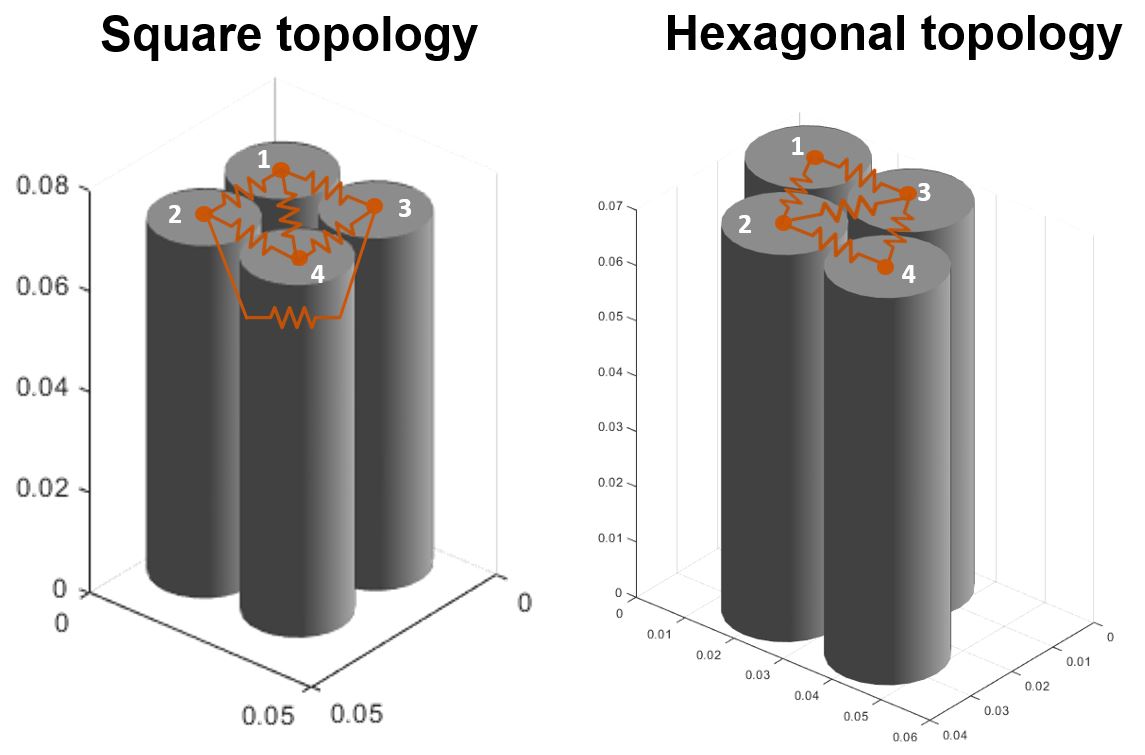de la Vega - 2024-03-20T11:30:12+00:00
Question: How is InterCellThermalPath property working?
I have created two Parallel Assemblies, one with hexagonal topology (left) and one with square topology (right), and I have noticed that their InterCellThermalPath is different. This makes sense, but I do not understand how this property works when the topology is square. My question is the following: are the yellow connections well drawn? I mean, each cell transfers heat by convection to a common thermal node? In any case, two months ago I asked MathWorks technical support about this property and they replied that each InterCell resistance has, by default, a value of 1.2 K/W. So: how is all this possible? According to Simscape Battery, the Ambient-Cell thermal resistance is 25 K/W, so I do not quite understand how this thermal path works.
Expert Answer
 John Michell answered .
2025-11-20
John Michell answered .
2025-11-20
Enabling "InterCellThermalPath" for cylindrical cells will add a single thermal resistor between the thermal node of each cell and the node of each neighboring adjacent cell. For your example, the thermal circuits would look similar to the following figure:
For "Square" topologies, all of the cell neighbors will be connected, while for the "Hexagonal" topology, cells 1-4 would not be directly connected thermally because they would be considered to be too far away geometrically. This is the only difference.
The default thermal resistance value assigned to each resistor is 1.2 K/W, however, this value depends on many things, like cell format/geometry/size, and the material (if any) which is present between the cells. The thermal resistance value needs to be parameterized for each application and cell format/geometry/size. This parameterization could be done with direct calculations or using more detailed 3D CFD models.
It should be possible to include better default values for these thermal resistances depending on cell geometry in Simscape Battery and we would definitely take that feedback onboard for our future development.
A thermal resistance value of 1.2 K/W might seem more reasonable to use for a larger pouch or prismatic battery cell (capacities higher than 30 Ah), however, might be too permissive for cylindrical cells.
1.How are the connections 1-4 and 2-3 working in the square topology? I mean, how can there be heat transfer by conduction when they are not physically joined? Was I right with my picture?
In modules made up of cylindrical cells, it is common for all the inter-cell space to be filled with a potting compound or a thermal interface material which would stablish a conduction heat path between all cells. This conduction heat path can be very isolating or it can be very high depending on the design goal and safety considerations. For the square topology, 1-4 and 2-3 might have a solid material between them, because the distance is larger, then maybe you might want to set this thermal resistance to be higher than say the 1-2 or 1-3 connections, which should be possible in Simscape Battery. In cases were the connection 1-4 only has an air gap between them, then the thermal resistance would just represent some linear heat exchange or a lumped version of your 2 thermal resistances (from your yellow thermal diagram from the right hand image). We haven't added any features to specifically model convection and the air volume between the cells (like its shown with the yellow thermal circuit from your picture). Adding these extra functions might be desirable but they impact simulation speed a bit, so its better to try and recreate or capture those effects on the aggregate by properly parameterizing the lumped thermal resistances and thermal masses within your system. Its common to also see module designs with only a 1mm air gap (or thereabouts) between the cells, so modeling air and convection to a higher level of detail might be something to consider in the future.
2. Is there any way to change the value of this property?
Yes for sure. After you generate the library with the module .ssc block, you can double click on the mask and edit the value of the thermal resistance. This should be available from the thermal parameter section. You can input a scalar or a vector to define specific values for different cells connections.
Not satisfied with the answer ?? ASK NOW


 John Michell answered .
2025-11-20
John Michell answered .
2025-11-20
